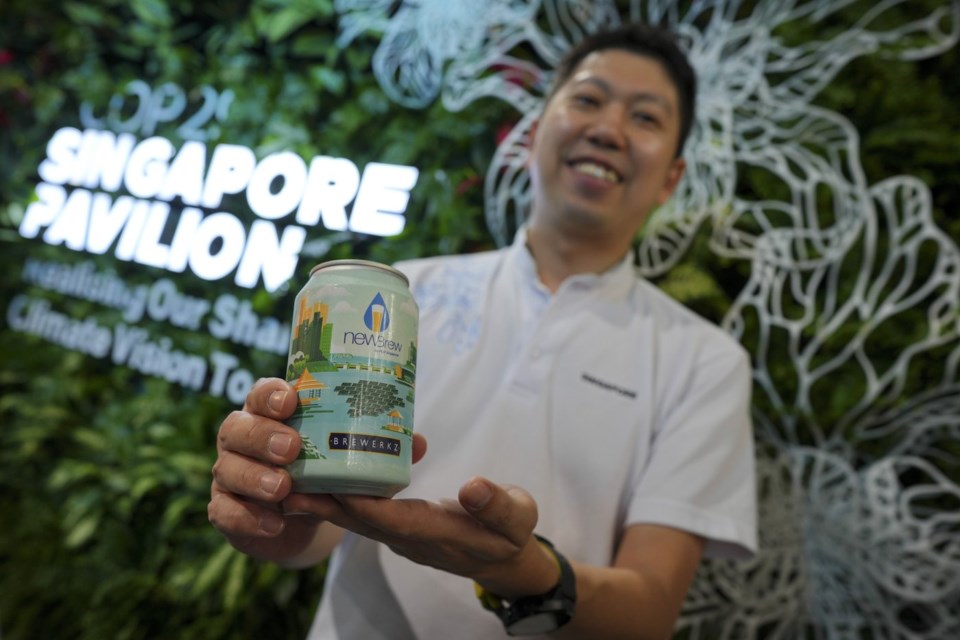BAKU, Azerbaijan (AP) — In the sprawling pavilion section of the United Nations climate talks, where countries, nonprofits and tech companies use big, flashy signs to get the attention of the thousands of people walking through, small aqua and purple beverage cans sit conspicuously on a counter at the Singapore display.
Those who approach learn that the cans are beer — a brand call NEWBrew — and free for anybody who asks. But there is something not everybody who cracks one open finds out right away, if at all: the beer is made with treated wastewater.
“I didn’t know. I was really surprised,” said Ignace Urchil Lokouako Mbouamboua, an international relations student from Congo, who recently sipped one while taking a break from the conference.
“I can even suggest that they make more and more of this kind of beer,” added Mbouamboua with a smile, sharing it was his third day in a row he stopped for a can.
NEWBrew is made in Singapore with NEWater, the name of treated wastewater that's part of a national campaign to conserve every drop in one of the world’s most water-starved places.
The drink, which some attendees jokingly call “sewage beer,” is one of many examples of climate- and environment-related innovations on display during this year's climate talks, COP29, taking place in Azerbaijan. Highlighting the use of treated wastewater underscores one of the world's most pressing problems as climate change accelerates: providing drinking water to a growing population.
For years, Singapore has been a leader in water . The city-state island of 6 million people in Southeast Asia, one of the most densely populated countries, has no natural water sources. In addition to water imports from Malaysia, the other pillars of its national strategy are catchment, desalination and recycling. Authorities have said they need to ramp up all water sources, as demand is expected to double by 2065.
While drinking treated wastewater is a novelty for many at the climate conference, for Singaporeans it's nothing new. National campaigns — from water conservation pleas to showing the wastewater recycling process — go back decades. In 2002, then-Prime Minister Goh Chok Tong was famously photographed drinking a bottle of NEWater after a tennis match, done to normalize its use.
Ong Tze-Ch’in, chief executive of the Public Utilities Board, Singapore's national water agency, said NEWBrew was developed by a local brewery in 2018. The idea was to showcase treated wastewater at the country's biennial International Water Week. The beer was next produced in 2022, 2023, then again this year.
“It's part of the acceptance of the use of recycled water, which in general is a difficult topic," said Ong. “We did many things to drive it.”
And is he happy with how it turned out?
“I chose this flavor,” said Ong, adding that he was part of the group that worked with the brewery for this year's version, a “modern pilsner.”
“You know, beer is always very subjective,” he added with a laugh.
After attending a panel on water management at the Singapore pavilion, Peter Rummel, director of infrastructure policy advancement at Bentley Systems, which creates infrastructure engineering software, stepped up to the counter and got a beer. Rummel told onlookers he was in a good position to judge beer, as he hailed from Munich, Germany, home to the Oktoberfest beer festival.
“It’s fresh, light, cool. It has a nice flavor,” said Rummel, while looking at the can.
Wee-Tuck Tan, managing director of the local brewery, The Brewerkz Group, said they have made about 5,000 liters, or roughly 15,000 cans, for each edition of NewBrew. He said they use the same process as with other beers, and the cost is also similar, about 7 Singaporean dollars (around $5 U.S.) per can when bought in a supermarket.
Wee-Tuck said he believes the beer has shifted how some in Singapore view NEWater.
“They think it tastes funny," he said. “When put into a beer, it changes the mindset. Most people can't tell the difference.”
As problems with water scarcity grow, there is increasing embrace of the use of treated wastewater, said Saroj Kumar Jha, the World Bank Group's global water department director, who participated in the water management panel in the Singapore pavilion. Traveling to over 50 countries in the last two years, he said leaders have frequently told him it's important not to use the term “wastewater,” and instead call it “used water.”
After the panel concluded, Jha and the other panelists opened NEWBrews and toasted.
“It's really good,” said Jha. “It's the fourth time I've had it.”
“This year," he added with a laugh. “Not today.”
___
This story corrects the date of the photograph of then Prime Minister Goh Chok Tong drinking NEWater to 2002.
___
The Associated Press’ climate and environmental coverage receives financial support from multiple private foundations. AP is solely responsible for all content. Find AP’s for working with philanthropies, a list of supporters and funded coverage areas at .
Peter Prengaman, The Associated Press



